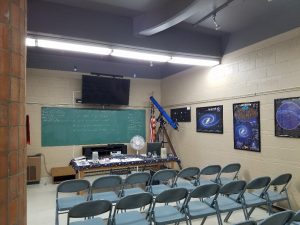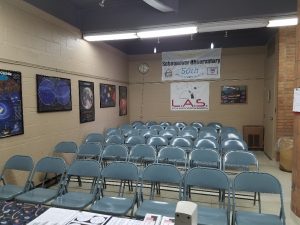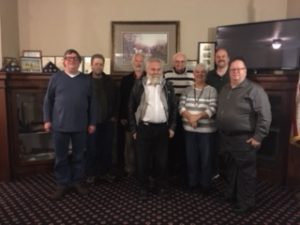Star Gazer March 2018
Schoonover Observatory 670 N. Jefferson Street, Lima, Ohio 45801
Mailing Address: Lima Astronomical Society, Box 201, Lima, OH 45802
Check us out on Facebook: The Lima Astronomical Society.
The Star Gazer is written by Sherry Cottle Graham. Please forward comments, suggestions, or to unsubscribe/subscribe to this newsletter to SherryCottle@gmail.com.
March 2, 2018 Meeting starts at 8:00 P.M. at the Schoonover Observatory
Key Member Training was offered to attendees.
Presentation for March 2, 2018 by Mark Casazza is, “Introduction to NEAF and NEAF Lecture, “M Young – Black Holes, Quasars, and Q2”.
Under the Dome
Lima Observatory Receives a Face Lift
We are pleased to announce that the Lima Parks Department has been working on the observatory’s interior. This is a report by Michael Ritchie who has been working with them on this project. Michael said, “You will all be happy to know that besides painting the main room, the city workers have removed the old flooring and are in the process of installing a new commercial vinyl floor and vinyl moldings.
They seem to be done painting but did not paint the inner door jambs or inner doors. I will have to find this out. All the work I did to remove everything from the walls and centralize everything in the room and cover has now been moved all over and stuffed into the two small rooms while they lay the floor. They didn’t have to do that as they could have laid 3/4th’s of the floor then moved the chairs and things to the new area to finish.”
We welcome everyone to come out and see a new and improved observatory this coming Friday night. Let’s hope that the weather permits, and we can do some star gazing while we are there.


Lima Astronomy Winter Party
The Lima Astronomical Society met at the Elks Club in Lima, Ohio on Saturday, February 17, 2018 at 6:30 PM for dinner and social gathering. During this time, they chatted about the improvements that are taking place at the observatory. They had a wonderful time and are planning another event this summer. Once they finalize this summer’s social event, we will announce it in the Star Gazer.

The Lima Astronomical Society’s members that attended the Winter Party are listed from left to right. David Humphreys, Doug Wire, Eugene McCall, Steve Neff, Earl Lhamon, Sherry Cottle Graham, Mark Casazza, and Michael Ritchie.
Astronomical Calendar for 2018 March
Date GMT Event
(h:m)
Mar 01 05:09 Regulus 0.9°S of Moon
02 00:51 FULL MOON
04 06 Mercury 1.1° of Venus
04 14 Neptune in Conjunction with Sun
07 06:57 Jupiter 4.1°S of Moon
09 11:20 LAST QUARTER MOON
10 00:37 Mars 3.8°S of Moon
10 11 Mercury at Perihelion
11 02:37 Saturn 2.2°S of Moon
11 09:13 Moon at Apogee: 404682 km
14 03:47 Moon at Descending Node
15 15 Mercury at Greatest Elong: 18.4°E
17 13:12 NEW MOON
18 19:07 Venus 3.7°N of Moon
19 08 Mercury 3.8° of Venus
20 16:15 Vernal Equinox
22 22:33 Aldebaran 0.9°S of Moon
24 15:35 FIRST QUARTER MOON
26 17:17 Moon at Perigee: 369104 km
27 00:52 Beehive 2.2°N of Moon
27 10:56 Moon at Ascending Node
28 13:38 Regulus 1.0°S of Moon
31 12:37 FULL MOON
2018
General Meetings for 2018 are on the first Friday of each month starting at 8:00 P.M.
Scheduled Events
- Astronomy Days #1, April 21, 2018 starting at 9:30 P.M. at Kendrick woods
- Perseids Meteor Shower, August 12-13, 2018 starting at dusk, at Kendrick Woods.
- Astronomy Days #2, October 13, 2018, from Noon to Evening, at Lima Schoonover Observatory.
- International Observe the Moon, October 20, 2018, starting at 6 P.M. at Kendrick Woods.
2019
50th Anniversary of the Apollo Lunar Landing, May 4th, 2019 at the Neil Armstrong Airport.
Night Out at the Neil Armstrong Museum, May 19th, 2019.
In The News
Most Distant Black Hole Yet
By: Camille M. Carlisle | December 6, 2017
351
Astronomers have discovered a supermassive black hole scarfing down gas just 690 million years after the Big Bang.
Astronomers are like historians on steroids. They doggedly push back the curtain of cosmic time, peering back to ever-earlier eras in the universe. The latest discovery in this quest, announced today in the journal Nature, is the quasar J1342+0928. This black-hole-powered beacon blazes at us from a redshift of 7.54, or a mere 690 million years after the Big Bang.
(Picture Removed)
The new supermassive black hole J1342+0928 (yellow star) is the most distant one found found to date (yellow dots). Its mass is comparable to those estimated for other early black holes.
Jinyi Yang / University of Arizona; Reidar Hahn / Fermilab; M. Newhouse / NOAO / AURA / NSF
This is not the earliest object astronomers have found: they’ve netted galaxies back to a mere 400 million years after It All Began. But J1342+0928 contains the earliest supermassive black hole detected, squeaking into first place some 50 million years ahead of the previous record holder.
Astronomers are actively hunting ancient quasars because they want to understand how the first supermassive black holes formed. To do that, they need to know how many there are in the early universe and how big they are at different times. This requires a census. As part of an ongoing, multi-survey search looking for the most distant quasars, Eduardo Bañados (Carnegie Institution for Science) and colleagues came upon J1342+0928. They were looking for sources shining at us from so far in the past that their light has been severely redshifted by cosmic expansion. J1342+0928 stuck out because it was invisible at shorter wavelengths but showed up at the longer, redder ones expected from objects in this distant era.
Based on J1342+0928’s brightness and how fast the gas whirls around the central black hole — determined thanks to how much the motion broadens the spectral line of singly ionized magnesium — the team estimates that the black hole has a mass of about 800 million Suns. That’s a little lower than the supplanted contender (J1120+0641, at 2 billion Suns) and within the ballpark for other supermassive black holes found a few hundred million years later.
Astronomers have been struggling for some time to understand how the universe grew such colossal black holes in less than a billion years. The options generally are that small black holes ate abnormally fast, or big clouds somehow collapsed directly into big black holes. The discovery of objects like J1342+0928 will one day help answer that question.
Not Just About the Black Hole
(Picture Removed)
This artist’s concept depicts looking back in cosmic time to the quasar J1342+0928. The black hole resides in a mostly neutral universe, 690 million years after the Big Bang, at a time when the first galaxies were appearing and carving bubbles in the neutral hydrogen gas filling the universe.
Robin Dienel / Carnegie Institution for Science
Follow-up work, published by several of the same team members and headed up by Bram Venemans (Max Planck Institute for Astronomy, Germany) in Astrophysical Journal Letters, tracked down the radio glow from gas and dust in J1342+0928’s host galaxy. Interpreting the data takes a fair bit of extrapolating, but broadly speaking, the galaxy appears to be small and very dusty.
Another galaxy with the same cosmic age, A1689-zD1, also has a lot of dust — but not as much as J1342+0928. In fact overall, the dustiness of the quasar’s host galaxy is higher than “normal” galaxies seen at similar cosmic times, but it parallels the levels found for other high-redshift quasars.
Dust comes from aging or dying stars. Early galaxies often pumped out stars rapidly, which might explain these levels. Still, it remains unclear what the results tell us about starbirth in these systems.
One of the most important aspects of the newly discovered quasar, however, is its larger environment. Using the quasar’s beam as a backlight, the team spotted the distinct spectral signs of neutral hydrogen gas in the vicinity. Astronomers have also seen neutral hydrogen around the second-earliest quasar, J1120+0641, but almost none around quasars a couple hundred million years later.
This result proves that J1342+0928 sits in the epoch of reionization, when radiation from early galaxies tore apart the hydrogen atoms filling the universe and left the hydrogen ionized — a state the universe is still predominantly in today. Reionization is a fundamental change, like dawn hitting the universe.
The team estimates that the hydrogen around J1342+0928 is about 50/50 split between neutral and ionized. That favors a late date for reionization, which would jibe with results based on the cosmic microwave background
Mission Statement
Mission Statement: To promote knowledge of astronomy and science (in general) for the residents in and around our community.
Membership Renewals for 2018 year are now due. Please send your checks to: Lima Astronomical Society, Box 201, Lima, OH 45802. The price is: Student $15: Individual $20: Family $25: Life Time $300.
End of Star Gazer
